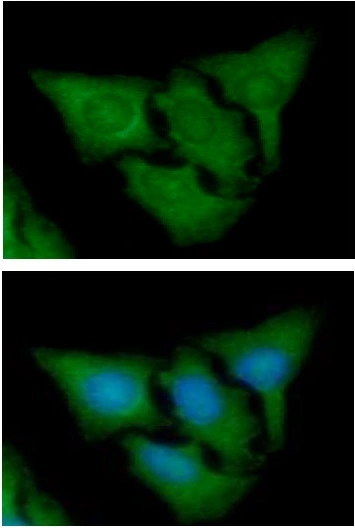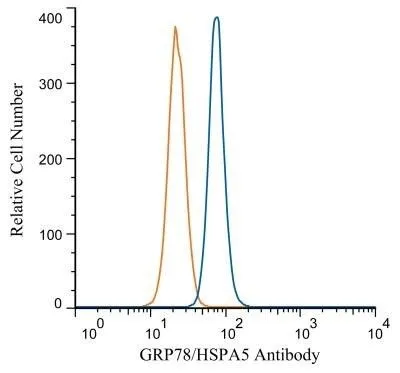Grp78 antibody
GTX113340
ApplicationsImmunoFluorescence, Western Blot, ImmunoCytoChemistry, ImmunoHistoChemistry, ImmunoHistoChemistry Paraffin
Product group Antibodies
TargetHSPA5
Overview
- SupplierGeneTex
- Product NameGrp78 antibody
- Delivery Days Customer9
- Application Supplier NoteWB: 1:5000-1:20000. ICC/IF: 1:100-1:1000. IHC-P: 1:100-1:1000. *Optimal dilutions/concentrations should be determined by the researcher.Not tested in other applications.
- ApplicationsImmunoFluorescence, Western Blot, ImmunoCytoChemistry, ImmunoHistoChemistry, ImmunoHistoChemistry Paraffin
- CertificationResearch Use Only
- ClonalityPolyclonal
- Concentration1.13 mg/ml
- ConjugateUnconjugated
- Gene ID3309
- Target nameHSPA5
- Target descriptionheat shock protein family A (Hsp70) member 5
- Target synonyms78 kDa glucose-regulated protein; binding-immunoglobulin protein; BIP; endoplasmic reticulum chaperone BiP; endoplasmic reticulum lumenal Ca(2+)-binding protein grp78; epididymis secretory sperm binding protein Li 89n; glucose-regulated protein, 78kDa; GRP78; heat shock 70kDa protein 5 (glucose-regulated protein, 78kDa); heat shock protein 70 family protein 5; heat shock protein family A member 5; HEL-S-89n; HSP70 family protein 5; immunoglobulin heavy chain-binding protein
- HostRabbit
- IsotypeIgG
- Protein IDP11021
- Protein NameEndoplasmic reticulum chaperone BiP
- Scientific DescriptionWhen Chinese hamster K12 cells are starved of glucose, the synthesis of several proteins, called glucose-regulated proteins (GRPs), is markedly increased. Hendershot et al. (1994) [PubMed 8020977] pointed out that one of these, GRP78 (HSPA5), also referred to as immunoglobulin heavy chain-binding protein (BiP), is a member of the heat-shock protein-70 (HSP70) family and is involved in the folding and assembly of proteins in the endoplasmic reticulum (ER). Because so many ER proteins interact transiently with GRP78, it may play a key role in monitoring protein transport through the cell.[supplied by OMIM]
- Storage Instruction-20°C or -80°C,2°C to 8°C
- UNSPSC12352203
References
- Vachellia farnesiana Pods or a Polyphenolic Extract Derived from Them Exert Immunomodulatory, Metabolic, Renoprotective, and Prebiotic Effects in Mice Fed a High-Fat Diet.Read more
- Up-regulation of Thioredoxin 1 by aerobic exercise training attenuates endoplasmic reticulum stress and cardiomyocyte apoptosis following myocardial infarction.Read more
- Signal Sequence-Dependent Orientation of Signal Peptide Fragments to Exosomes. Ono K et al., 2022 Mar 15, Int J Mol SciRead more
- The aqueous fraction of Castanea crenata inner shell extract reduces obesity and intramuscular lipid accumulation via induction of mitochondrial respiration and fatty acid oxidation in muscle. Lee SR et al., 2022 Feb 2, PhytomedicineRead more
- Naringenin Induces ROS-Mediated ER Stress, Autophagy, and Apoptosis in Human Osteosarcoma Cell Lines. Lee CW et al., 2022 Jan 7, MoleculesRead more
- The Cell Protective Effect of Adenine on Hypoxia-Reoxygenation Injury through PPAR Delta Activation. Leu JG et al., 2021 Dec 16, Life (Basel)Read more
- A novel mechanism linking ferroptosis and endoplasmic reticulum stress via the circPtpn14/miR-351-5p/5-LOX signaling in melatonin-mediated treatment of traumatic brain injury. Wu C et al., 2022 Jan, Free Radic Biol MedRead more
- Shared and specific functions of Arfs 1-5 at the Golgi revealed by systematic knockouts.Read more
- The AKT modulator A-443654 reduces alpha-synuclein expression and normalizes ER stress and autophagy. Gandelman M et al., 2021 Oct, J Biol ChemRead more
- ATF6 is required for efficient rhodopsin clearance and retinal homeostasis in the P23H rho retinitis pigmentosa mouse model. Lee EJ et al., 2021 Aug 11, Sci RepRead more



![ICC/IF analysis of HeLa cells using Grp78 antibody [9E4-2A7-H6] at a dilution of 1:50.](https://www.genetex.com/upload/website/prouct_img/normal/GTX16489/GTX16489_ICCIF_w_23060620_805.webp)



![IHC-P analysis of human breast carcicnoma tissue using GTX33997 Grp78 antibody [10C9]. Dilution : 1:200](https://www.genetex.com/upload/website/prouct_img/normal/GTX33997/GTX33997_20200622_IHC-P_264_w_23060801_846.webp)
![IHC-P analysis of human breast carcicnoma tissue using GTX33998 Grp78 antibody [8G3]. Dilution : 1:200](https://www.genetex.com/upload/website/prouct_img/normal/GTX33998/GTX33998_20200622_IHC-P_265_w_23060801_345.webp)